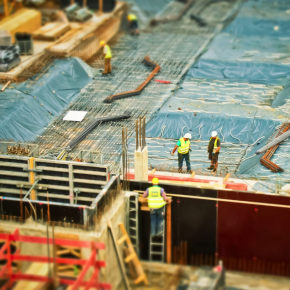
The most common injuries in construction work and how to avoid them
There are many risks that companies and individuals must be aware of and aim to prevent on construction sites. While this can be a dangerous industry to operate in, sites should always run safely and efficiently to minimise any potential harm to workers.
Construction companies should undertake risk assessments to outline all potential risks on each job and implement strategies to reduce these risks.
While all precautions may be in place to reduce risks, unfortunately, accidents can happen. So what are the most common injuries sustained by construction workers in Britain?
25% of non-fatal injuries are caused by slips, trips and falls
The latest statistics from HSE have shown that slips, trips and falls are the most common non-fatal accidents experienced by UK construction workers. In the year 2018-19, there were 1,223 reported slips, trips and falls, of which 509 were specified – which RIDDOR defines as “fitting within their pre-defined list of injuries”. Further to this, 714 people had to take over seven days off work due to the injuries they sustained.
What causes slips, trips and falls?
Unfortunately, tripping over objects can happen in any workplace or construction site. People can easily slip on a substance that has been spilt on the floor and not cleaned up, trip over loose wires or fall into holes that have not been adequately signposted.
How can these types of accident be prevented?
Before any work is undertaken, all workers should complete safety training, so they are aware of any potential hazards. The training should educate them on safety standards that must be followed, and they should be given access to all company policies regarding health and safety, as well as told who the site first aider is.
Further to this, all workers must have appropriate PPE (personal protective equipment) to protect them from hazards. This may include a hard hat, goggles, gloves, safety boots and high-vis jackets. If the site will be particularly noisy, they may also require ear defenders or plugs.
When it comes to slips and trips, protection systems should be in place to stop them from happening. This may be guardrails, scaffolding, nets or other structures to ensure staff safety. All areas should be kept clean and tidy, with walkways free from clutter, debris or spills to reduce these types of accidents.
What to do after a work-related accident
Firstly, you should report your accident at work to your employer, in the company accident book, and to your doctor. It’s also worth taking photos of your injury and writing down exactly what happened afterwards so you don’t forget any details. If there was anyone with you at the time, get their contact details and ask them to make notes too.
If you are unable to work because of your injury, you may be able to claim Statutory Sick Pay, which can be claimed for 28 weeks. You can check whether you’re eligible on the government website. You may also be able to claim compensation if the accident wasn’t your fault, through companies like National Accident Law. They will listen to your situation and offer you free, impartial advice so you can decide what to do next.
One comment on “The most common injuries in construction work and how to avoid them”
Leave a Reply
You must be logged in to post a comment.
Latest news

30th April 2025
Digital Construction Week announces seminar programme for its landmark 10th edition
Digital Construction Week (DCW) returns to ExCeL London on 4 – 5 June 2025 with its most impactful programme yet. It brings together the best and brightest from across AECO, for two days of practical learning and idea sharing.
Posted in Articles, Building Industry Events, Building Industry News, Building Products & Structures, Building Services, Building Systems, Exhibitions and Conferences, Information Technology, news, Restoration & Refurbishment, Retrofit & Renovation, Seminars
29th April 2025
Senior pledges to ‘bee’ part of the solution with new biodiversity initiative
Senior Architectural Systems has installed its first on-site beehive, marking another step forward in its commitment to sustainability and biodiversity.
Posted in Articles, Building Industry News, Building Products & Structures, Building Services, Curtain Walling, Doors, Glass, Glazing, Innovations & New Products, news, Restoration & Refurbishment, Retrofit & Renovation, Sustainability & Energy Efficiency, Walls, Windows
29th April 2025
West Fraser range delivering key benefits for South-East carpentry company
An experienced carpenter and building site manager who has recently set up his own company is using high performance panel products from the West Fraser range.
Posted in Articles, Building Industry News, Building Products & Structures, Building Systems, Case Studies, Garden, Restoration & Refurbishment, Retrofit & Renovation, Sustainability & Energy Efficiency, Timber Buildings and Timber Products
29th April 2025
CPD Courses Available Online From Ecological Building Systems
Ecological Building Systems, a leading supplier of natural building products for sustainable construction, has revealed its comprehensive CPD programme for the year ahead.
Posted in Articles, Building Industry Events, Building Industry News, Building Products & Structures, Building Services, Continuing Professional Development (CPD's), Information Technology, Innovations & New Products, Insulation, Restoration & Refurbishment, Retrofit & Renovation, Seminars, Sustainability & Energy Efficiency, Training, Walls, Waste Management & Recycling

One in five workplace fatalities is construction-related according to EHS. Workplace accidents might result in a fatality, permanent disability, or time lost by an employee who is now unable to work for a day or more. If this worker had an important job working as part of a team; this team may not be able to carry out their job as efficiently or at all, until a new worker is available. When you calculate all the costs for workplace mishaps, the numbers are staggering. In order to lower workplace accidents as much as possible, companies have the responsibility to plan ahead for safety and train everyone to work safely. Implementing an effective safety training program can be challenging and this article talks about how to implement workplace safety training with lower costs and time workplace safety training Both employers and employees have to make an effort to make sure every worker can go home safe and healthy everyday.